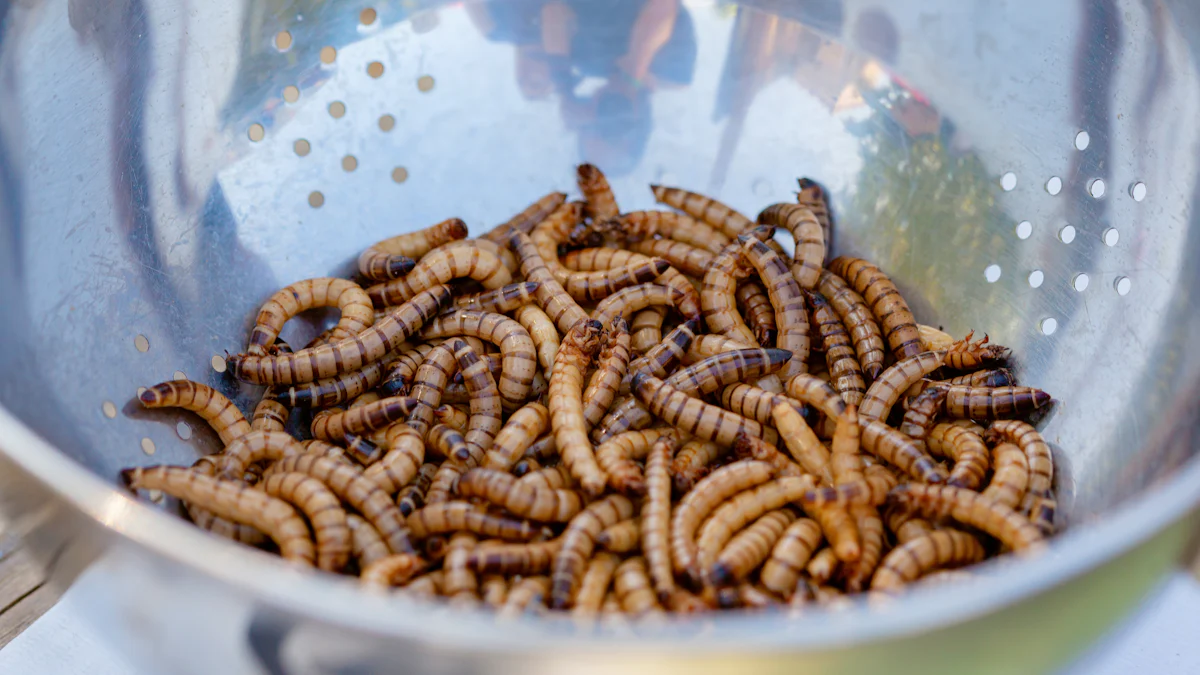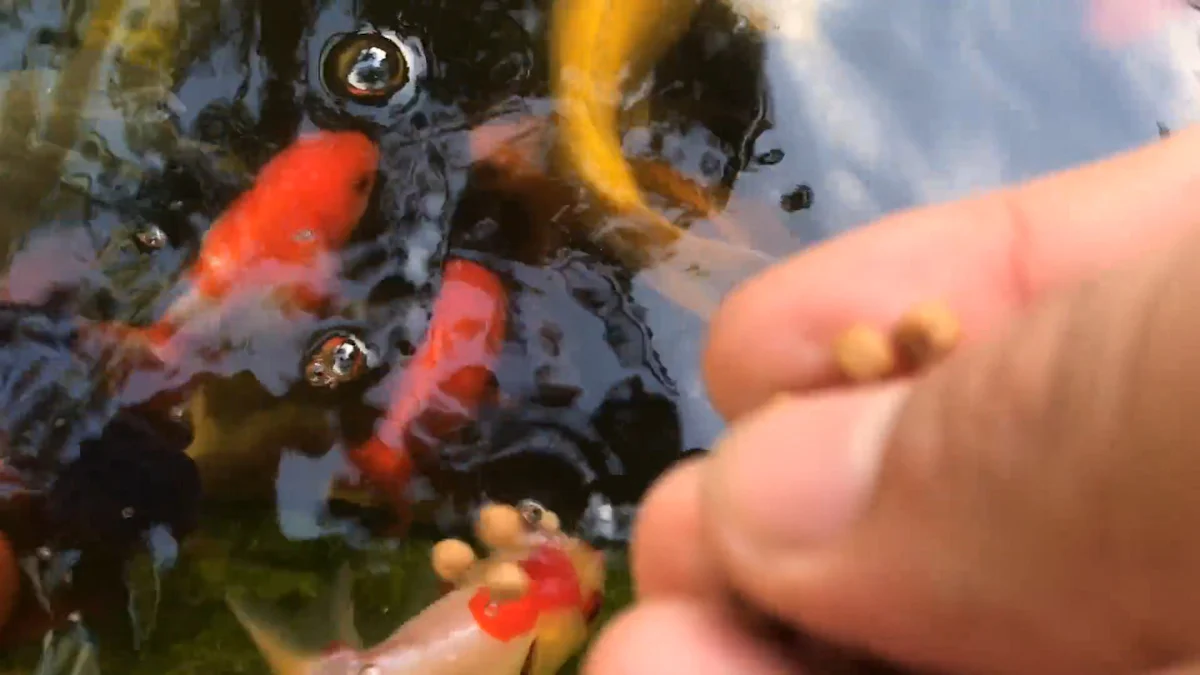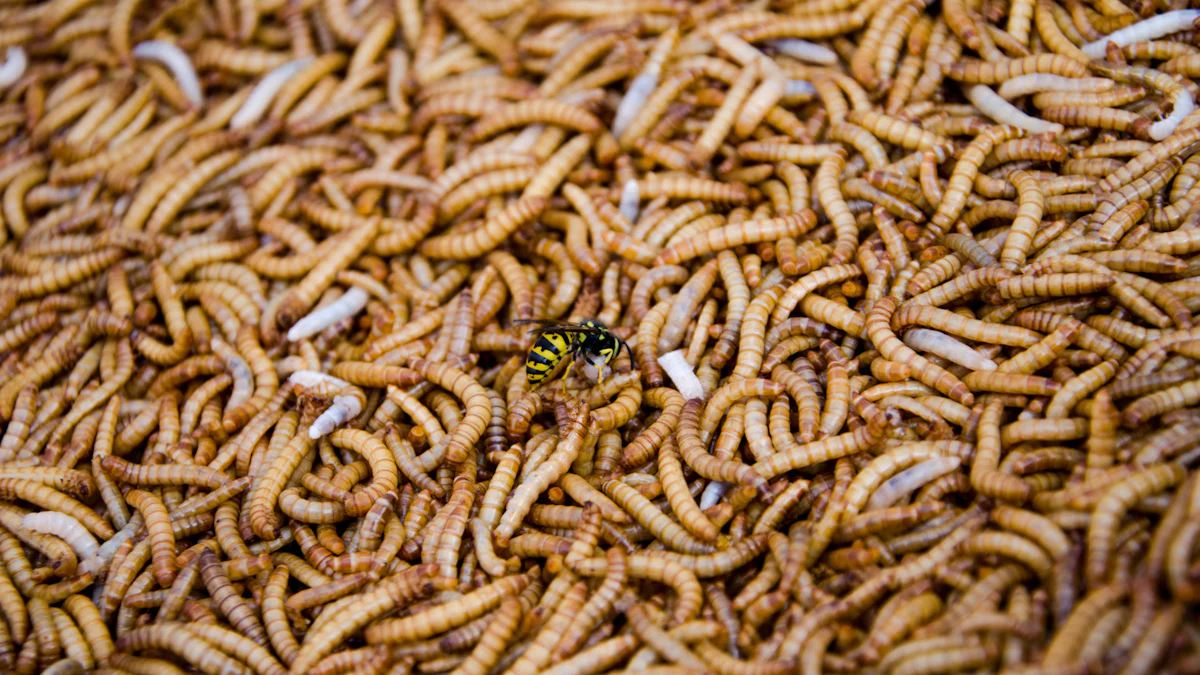
Fish eat dried mealworms with enthusiasm, and it’s easy to see why. These nutrient-packed snacks provide a rich source of protein and essential nutrients that contribute to fish growth and overall health. Since fish eat dried mealworms that closely resemble their natural diet, they are an attractive choice for both carnivorous and omnivorous species. The high protein content boosts energy levels, while the fatty acids enhance vibrant scales and strengthen immune systems. However, it’s important to feed them in moderation. Overfeeding can upset a balanced diet, and ensuring the mealworms are of high quality is crucial for safety. When offered thoughtfully, dried mealworms can be a nutritious and enjoyable addition to a fish’s diet.
Key Takeaways
- Dried mealworms are a nutrient-rich snack that provides high protein and essential fatty acids, promoting fish growth and vibrant health.
- These mealworms closely resemble the natural diet of many fish species, making them an appealing and instinctual food choice.
- Moderation is crucial; feed dried mealworms once or twice a week to complement a balanced diet without overloading on fats.
- Always choose high-quality dried mealworms from reputable suppliers to ensure safety and nutritional value for your fish.
- Consider the size of your fish when feeding; break mealworms into smaller pieces for smaller species to prevent digestive issues.
- Dried mealworms are a sustainable feeding option, requiring fewer resources to produce compared to traditional protein sources.
- Incorporating dried mealworms into your fish’s diet can enhance their overall vitality and immune system, making feeding time enjoyable.
Nutritional Value and Benefits of Dried Mealworms

Why Fish Eat Dried Mealworms
Fish naturally gravitate toward dried mealworms because they mimic the insects found in their wild habitats. These mealworms provide a satisfying crunch and a flavor that appeals to both carnivorous and omnivorous species. For pond fish like koi, dried mealworms offer a treat that aligns with their instinctual feeding habits. The resemblance to their natural diet makes dried mealworms an enticing option, encouraging fish to eat with enthusiasm.
Additionally, dried mealworms serve as a sustainable food source. They support eco-friendly feeding practices while delivering essential nutrients. This combination of taste, texture, and sustainability explains why fish eat dried mealworms so readily.
High Protein and Fat Content
Dried mealworms pack a powerful punch of protein and healthy fats. Protein plays a critical role in muscle development and growth, making it essential for fish of all sizes. The high protein content in mealworms ensures that fish maintain their energy levels and stay active throughout the day.
The fats in dried mealworms contribute to vibrant scales and a robust immune system. These fatty acids help fish combat stress and environmental changes, keeping them healthy in various water conditions. For species like bettas and goldfish, the nutritional boost from mealworms can enhance their overall appearance and vitality.
Essential Nutrients for Fish Health
Beyond protein and fats, dried mealworms contain a variety of vitamins and minerals that promote fish health. They are rich in essential fatty acids, which support brain function and reproductive health. Vitamins like B12 and minerals such as iron and zinc contribute to stronger bones and improved oxygen circulation.
Feeding dried mealworms also helps replicate the diverse diet fish would encounter in the wild. This variety ensures that fish receive a balanced intake of nutrients, reducing the risk of deficiencies. By incorporating dried mealworms into their diet, fish owners can provide a wholesome and enriching feeding experience.
Suitable for Carnivorous and Omnivorous Fish Species
Carnivorous and omnivorous fish thrive on diets that closely resemble their natural feeding habits. Dried mealworms fit perfectly into this category, offering a protein-rich snack that supports their growth and vitality. These fish species instinctively seek out high-protein foods, making mealworms an irresistible choice. The crunchy texture and nutrient-packed profile of dried mealworms mimic the insects they would consume in the wild, ensuring a satisfying and enriching feeding experience.
For carnivorous fish like oscars or arowanas, dried mealworms provide the essential fatty acids needed for muscle development and energy. These nutrients help maintain their active lifestyles and enhance their vibrant coloration. Omnivorous species, such as goldfish or mollies, also benefit from the balanced nutrition mealworms offer. The combination of protein and fats contributes to their overall health, ensuring they remain lively and robust.
Fish eat dried mealworms with enthusiasm, but their size and feeding habits must be considered. Smaller fish may struggle with whole mealworms, so breaking them into smaller pieces ensures easy consumption. Larger species, on the other hand, can enjoy them as a hearty treat. By tailoring the portion size to the fish, owners can maximize the benefits of this nutritious food source.
Dried mealworms also serve as a versatile option for both pond and aquarium fish. Pond fish, such as koi, relish the opportunity to snack on mealworms floating on the water’s surface. Aquarium fish enjoy the same benefits, with mealworms adding variety to their diet. This adaptability makes dried mealworms a valuable addition to the feeding routine of carnivorous and omnivorous fish alike.
Comparing Dried Mealworms to Other Fish Food Options

Advantages of Dried Mealworms
Dried mealworms stand out as a convenient and nutrient-rich option for feeding fish. Their high protein content supports muscle growth and energy, making them ideal for active species. Unlike live mealworms, dried ones have a longer shelf life and require no special care, such as refrigeration or feeding. This makes them a practical choice for fish owners who want to avoid the hassle of maintaining live food.
Another advantage lies in their versatility. Dried mealworms can be fed to both pond and aquarium fish, offering a treat that floats on water or sinks when broken into smaller pieces. This adaptability ensures that fish of various sizes and feeding habits can enjoy them. Additionally, dried mealworms are lightweight and easy to store, making them a popular choice for hobbyists and commercial fishkeepers alike.
Compared to traditional protein sources like beef or chicken, dried mealworms offer a more sustainable option. They require fewer resources to produce and leave a smaller environmental footprint. This eco-friendly aspect appeals to those who prioritize sustainability in their feeding practices.
Drawbacks of Dried Mealworms
Despite their benefits, dried mealworms come with a few limitations. Their exoskeleton, while crunchy and appealing to fish, can be difficult for some species to digest. Smaller fish, in particular, may struggle with whole mealworms, which could lead to digestive issues if not properly prepared.
Nutritionally, dried mealworms fall short when compared to live mealworms. The drying process can reduce certain nutrients, making live mealworms a better choice for fish that require a higher level of digestibility and freshness. However, live mealworms demand more effort to maintain, which may not suit every fish owner.
Overfeeding dried mealworms can also disrupt a fish’s balanced diet. Their high fat content, while beneficial in moderation, may lead to health problems if consumed excessively. Fish owners must carefully regulate portions to avoid these risks.
How to Incorporate Dried Mealworms into a Balanced Diet
Incorporating dried mealworms into a fish’s diet requires thoughtful planning. The size of the mealworms should match the size of the fish. For smaller species, breaking the mealworms into tiny pieces ensures safe consumption. Larger fish can handle whole mealworms, making them an excellent occasional treat.
Moderation plays a key role in feeding dried mealworms. They should complement, not replace, the primary diet. A varied feeding routine that includes pellets, flakes, and other protein sources ensures fish receive all the nutrients they need. Offering dried mealworms once or twice a week strikes a healthy balance.
Proper storage is essential to maintain the quality of dried mealworms. Keeping them in a cool, dry place prevents spoilage and preserves their nutritional value. High-quality mealworms sourced from reputable suppliers guarantee safety and freshness, reducing the risk of contamination.
By following these steps, fish owners can provide a nutritious and enjoyable feeding experience. Fish eat dried mealworms with enthusiasm, but a balanced approach ensures they thrive in the long term.
Ensuring the Safety of Dried Mealworms
Sourcing High-Quality Dried Mealworms
Choosing high-quality dried mealworms ensures the safety and health of fish. Reputable suppliers raise mealworms in controlled environments, free from harmful chemicals like pesticides. This careful process guarantees a clean and nutritious product. Companies such as Promeal emphasize sustainability and quality by feeding mealworms nutrient-rich diets, which enhances their nutritional value.
Fish owners should always verify the source of their dried mealworms. Trusted brands often highlight their commitment to safety and quality on packaging or websites. Look for labels that mention pathogen-free production and adherence to strict safety standards. By selecting premium dried mealworms, fish owners can provide a safe and reliable protein source for their aquatic pets.
Proper Storage and Handling
Proper storage preserves the freshness and nutritional value of dried mealworms. Exposure to moisture or heat can lead to spoilage, reducing their quality and posing risks to fish health. Storing mealworms in a cool, dry place, such as an airtight container, prevents contamination and extends their shelf life.
Handling dried mealworms with clean hands or utensils minimizes the risk of introducing bacteria. Avoid leaving the container open for extended periods, as this can attract pests or humidity. For long-term storage, refrigeration may be an option, but always check the product’s specific guidelines. Following these steps ensures that dried mealworms remain a safe and nutritious treat for fish.
Feeding Dried Mealworms in Moderation
Moderation is key when feeding dried mealworms to fish. Overfeeding can disrupt a balanced diet and lead to health issues, such as obesity or digestive problems. Fish owners should treat mealworms as a supplement rather than a primary food source. Offering them once or twice a week provides variety without overwhelming the fish’s nutritional needs.
Portion size matters. Smaller fish may struggle with whole mealworms, so breaking them into smaller pieces ensures easy consumption. Larger fish can enjoy whole mealworms as an occasional treat. Observing the fish’s behavior during feeding helps determine the appropriate amount. A balanced approach keeps fish healthy and allows them to enjoy the benefits of this protein-packed snack.
Dried mealworms offer a nutritious and sustainable option for fish, packed with protein, essential fatty acids, and vital nutrients. They enhance fish health, supporting growth, vibrant scales, and energy. When sourced from reputable suppliers and stored properly, they remain safe and beneficial.
Fish thrive on variety, so dried mealworms should complement a balanced diet rather than replace it. Feeding them in moderation ensures fish enjoy their benefits without compromising overall nutrition. By incorporating dried mealworms thoughtfully, fish owners can provide a delightful and enriching treat that keeps their aquatic pets happy and healthy.
FAQ
Can dried mealworms be a valuable addition to the diet of fish?
Absolutely! Dried mealworms provide a high-protein food source that supports healthy growth, vibrant coloration, and overall well-being in fish. They mimic the natural diet of many species, making them an excellent supplement. When fish eat dried mealworms, they gain essential nutrients that enhance their vitality and immune system.
Are dried mealworms suitable for all fish species?
Not all fish species can handle dried mealworms. Carnivorous and omnivorous fish benefit the most from them due to their protein-rich nature. Smaller fish may struggle with whole mealworms, so breaking them into smaller pieces ensures safe consumption. Herbivorous fish, however, may not find them suitable as they require plant-based diets.
How often should fish eat dried mealworms?
Fish should eat dried mealworms in moderation. Offering them once or twice a week as a treat or supplement works best. Overfeeding can disrupt a balanced diet and lead to health issues. A varied feeding routine ensures fish receive all the nutrients they need.
Do dried mealworms need special preparation before feeding?
Dried mealworms require minimal preparation. For smaller fish, breaking them into smaller pieces helps with easy consumption. Larger fish can enjoy them whole. Always ensure the mealworms are fresh and stored properly to maintain their nutritional value.
Can dried mealworms replace a fish’s primary diet?
No, dried mealworms should not replace a fish’s primary diet. They work best as a supplement to a balanced feeding routine. Combining them with pellets, flakes, and other protein sources ensures fish receive a complete range of nutrients.
Are dried mealworms safe for fish?
Yes, dried mealworms are safe when sourced from reputable suppliers. High-quality mealworms raised in controlled environments ensure they are free from harmful chemicals or pathogens. Proper storage and handling further guarantee their safety.
What are the benefits of feeding fish dried mealworms?
Dried mealworms offer numerous benefits. They provide high protein for muscle growth, healthy fats for vibrant scales, and essential nutrients for overall health. Fish eat dried mealworms with enthusiasm, making them a delightful and nutritious treat.
How should dried mealworms be stored?
Store dried mealworms in a cool, dry place, preferably in an airtight container. This prevents moisture and contamination, preserving their freshness and nutritional value. Avoid exposing them to heat or humidity, which can lead to spoilage.
Can pond fish eat dried mealworms?
Yes, pond fish like koi and goldfish enjoy dried mealworms. These floating treats align with their natural feeding habits, making them an excellent choice for outdoor ponds. Breaking the mealworms into smaller pieces ensures even smaller pond fish can consume them easily.
Are dried mealworms environmentally friendly?
Dried mealworms are an eco-friendly option. They require fewer resources to produce compared to traditional protein sources like beef or chicken. Their sustainable production makes them a great choice for environmentally conscious fish owners.


